| 1 | A classic mid-venomous species |
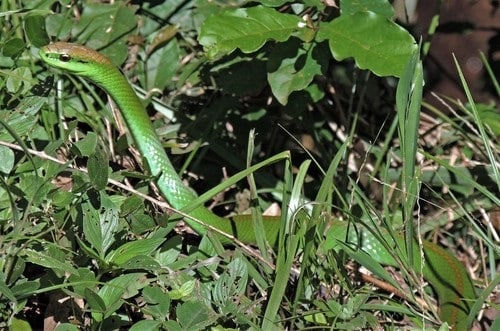
The Amazon rainforest contains hundreds of weird snakes, from thick vipers that grind forward inch by inch, to fast-moving bush snakes that peer at you with a pair of glowing eyes. One of the better researched, while still being barely heard of by Westerners, is Lichtenstein’s green racer (Philodyras olfersii), a classic moderately venomous species.
This snake inhabits a gigantic swathe of South America, covering well over half of Brazil, and ranging from Guyana and French Guinea in its northern territories, to northeast Argentina in the far south. Philodryas olfersii is abundant in São Paulo state in southeast Brazil, as well as Bolivia to the southwest, and covers virtually the whole of Paraguay.
This species averages at 90-110cm, with a maximum of 150cm, and females being longer than males. They’re thin-bodied, allowing them to easily climb branches, and weave across thin ones without snapping them and plummeting to their doom.
Lichtenstein’s green racer is a highly green snake, with few patterns, except a black line crossing through its eye, which is sometimes missing. This snake has nothing to do with the country of Liechtenstein. It was actually named after German explorer Martin Lichtenstein, who identified the species in 1823.
| 2 | Goal: avoid getting chewed |
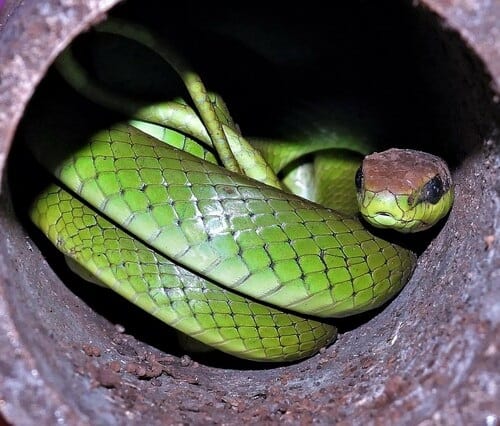
Lichtenstein’s green racer is venomous, and the picture is mixed. Its powers are limited by being a rear-fanged snake. This is a “chewing” snake, as rather than instantly injecting 100mg through its front fangs, Philodyras olfersii must repeatedly massage the venom into its victims, allowing a slowly-secreted venom to soak in through the wound. To survive, all you must do is rip the snake off your arm instantly, rather than casually leaving it attached for 5 minutes. That said, one death has been confirmed from this snake, in a 10 month old child who was bitten three times.
While no jararaca, Lichtenstein’s green racer causes a respectable total of bites. From 1987 to 1994, 85 snakes bites were admitted to Hospital Vital Brazil, Säo Paulo, who were later confirmed as Philodyras olfersii victims. A 1994 study identified 5 toxins in Lichtenstein’s green racer venom, one with haemorrhaging powers.
Lichtenstein’s green racer belongs to the 16-member Philodyras family, all of which are moderately venomous. Another is the Miranda green racer, and none contribute a large chunk to Brazil’s annual snakebite statistics. But some are worse than others, and in a 2023 comparison of 8 closely related species, Philodryas olfersii venom had the highest quantity of metalloproteinases, and serine proteases. These toxin classes trigger both local swelling and necrosis, and haemorrhaging via assaulting blood vessel walls. The metalloproteinases made up 63% of the venom, versus 58.4% for the Miranda green racer and 52.6% for the Patagonia green racer.
| 3 | Hides from humans in streams |
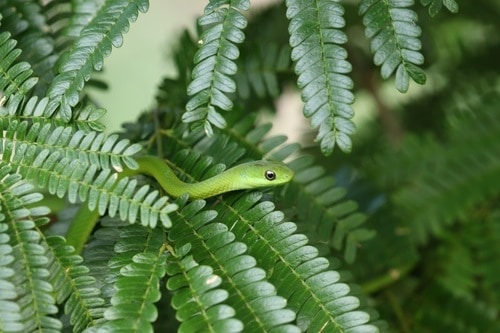
Lichtenstein’s green racer is only active during the daytime. They rarely appear in more open areas like meadows, sticking closely to forests and forest edges. However, if trees are plentiful, they can inhabit city suburbs such as in Campinas, southeast Brazil.
Lichtenstein’s green racers can hunt frogs while 3 metres high on a branch, sometimes plummeting to the ground as they lose their balance. They also do this on purpose, dropping down to escape predators, similarly to a brown watersnake of Florida. The setting was the edge of a forest stream in the Brazilian state of Rio Grande do Sul. The date was November 27th 2015, and the first snake was sitting on a large rock. When the scientists approached, it immediately plunged into the stream, swam underwater, and appeared on the opposite side.
The second snake was found 30 metres from the original, and also fled into the water. But this time, it stayed still in a formation of rocky crevices below the surface. The racer’s eyes never left the scientists while it hid underwater, and it stayed in place for nearly 8 minutes. Philodryas olfersii also has its bite for self-defence, and another weapon is releasing a foul snake smell.
| 4 | Most bites occur by day |
Another study recorded 44 Lichtenstein’s green racer victims from 1982 to 1990, admitted to São Paulo’s Butantan Institute, which is Brazil’s main manufacturing facility for antivenom. 32 were male and 11 female, and their symptoms were recorded. Most bites struck the hands, and most occurred during daylight hours. There were no severe cases, and the most common symptom was local pain, at 37.2% of victims. This was followed by swelling (34.9%), erythema (18.6%), and bruising (9.3%). Blood clotting was tested, and found to be normal, fully coagulable.
Most effects were local, but a child experienced abdominal pain and vomited three times. 11 victims were aged 0-9, and 2 were sleeping at night, with the green racer sneaking into their bedroom. Another 8 were simply children playing, while 12 cases happened to people handling the snake.
The poor delivery system reared its head: 62.8% of victims (27) had symptoms caused by the venom, but 37.2% had no symptoms at all. This was much lower than the Australian tiger snake, for example, for which 56/60 victims once experienced symptoms and just 4 suffered a dry bite.
| 5 | Diet: a vast menu |
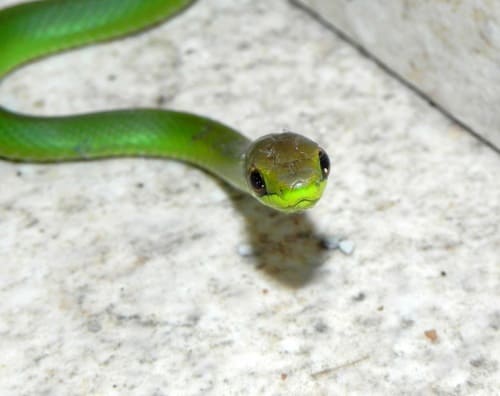
Lichtenstein’s green racers eat a relatively flexible diet. The first study took place in Rio Grande do Sul State, Brazil, near a flooded hydroelectric dam which conservationists were rescuing helpless creatures from. 68 racers were gathered and 47 food items were discovered inside. Rodents ruled, making up 61.7% of prey, followed by 12.8% for birds and 4.2% for amphibians. 21.3% were “not identified”, essentially a half-digested mush.
Study two took place in the Brazilian region of Santa Maria, Rio Grande do Sul State, in a forested area. It discovered 47 prey items in 140 Lichtenstein’s green racers, and reached a verdict of 53.1% amphibians, 19.2% birds and 23.5% mammals. Reptiles were a measly 4.2%, matching the dam study, where not one was discovered.
Identified species included the whistling frog and Montevideo tree frog. There were no snakes, unlike the Patagonian green racer it was compared to. But Philodyras olfersii was once found with a half-digested viper in its stomach, so it seems that fellow snakes are an occasional snack for them. This was a Bothrops member, either a jararaca, Neuwied’s pitviper or jararacussu.
Then there’s the opposite – getting eaten by fellow snakes. Lichtenstein’s green racer is eaten by its close relatives, as one was found in the stomach of a Patagonian green racer. The P. olfersii measured 100.7cm, while its predator wasn’t much longer at 115.0cm.
| 6 | One of the smarter snakes? |
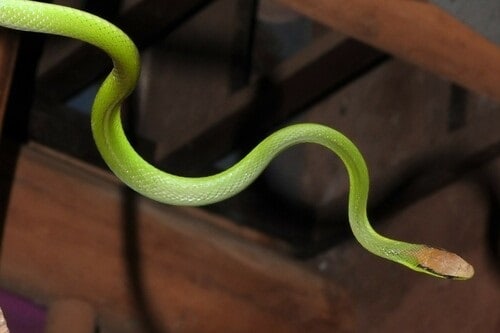
While snakes aren’t smart enough to plan out their entire next year, nor are they mindless creatures which roam the forest at random and eat any unfortunate frog they bump into. Hidden areas of intelligence are emerging each year, and one was revealed for Philodyras olfersii, in a study on a tree in the suburbs of Campinas, in São Paulo state, southeast Brazil.
This tree was particularly attractive to birds; the owners had installed a small bird feeder constantly filled with bananas, and juicy berries hung naturally from its branches. Over two months, scientists watched as a Lichtenstein’s green racer returned to the tree multiple times. The first day was January 22nd, when it managed to eat a house sparrow. Then it disappeared for 9 days, doing God knows what, before returning nine days later on January 31st, when it successfully hunted a bananaquit, swallowing it by the head.
Next came a gap of 44 days, when the racer returned to hunt a Sayaca tanager on March 16th, again swallowed by the head. Rather than hanging around lazily for 2 months, the snake had remembered the location of the tree, and made a point to return, proving a strong mental map of its landscape. The Australian green tree snake is another species confirmed to return to specific trees, even year after year.
| 7 | Why birds frown upon them |
It didn’t end in March either. A much larger gap followed, when the snake probably became a seasoned and travelled warrior. But 9 months and 2 weeks later, on December 30th 2006, it returned to its faithful tree.
This time, things didn’t go so well, as the Philodryas olfersii was mobbed by a family of Chalkbrowed mockingbirds, and made a failed lunge at an adult eared dove sitting in an empty nest. Two weeks later, on January 14th 2007, the green racer returned yet again. This was the last observation, but who knows how many years it returned to this outpost for. The snake was confirmed as the same individual by two irregularly marked ventral (belly) scales and a light fleck on another.
The study also showed how treacherous hunting can be for Lichtenstein’s green racers. Its attempts at hunting birds were repeatedly thwarted, as in two episodes, it attacked a bird but seized the wing at an awkward angle, forcing it to drag the bird back over the branches. The snake was repeatedly mobbed by gangs of several birds flapping and squawking, including ones it hadn’t even struck at, like rufous-collard sparrows and Rufous horneros. In one incident, the green racer was mobbed by 20 birds across 8 separate species, summoned into the frenzy of battle by the calls of other birds in distress. This one tree was like a whole community of combatants, yet the green racer clearly thought the hassle was worth it.
| 8 | Haemorrhaging, but no blood clotting |
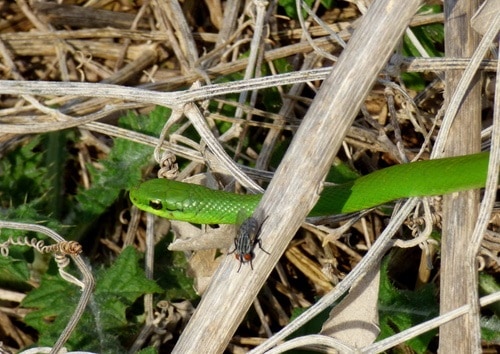
One symptom Lichtenstein’s green racer venom completely lacks is coagulopathy, AKA blood clotting disruption. The venom is moderately haemorrhagic, causing bursting blood vessels and spontaneous bleeding. But there’s very little ability to shred clotting ingredients like fibrin and fibrinogen, or disable cofactors like factor X, or even act as a procoagulant by accelerating fibrin production and therefore wasting clotting supplies. The Butantan Institute study found no clotting disruption, nor did a 2007 study on rats, despite observing moderate haemorrhaging. This is very different to its Bothrops pitviper neighbours in South America, like the common lancehead or green jararaca.
The same rat study analysed virtually everything except neurotoxic symptoms. Philodryas olfersii also scored highly for nociceptive activity, the ability to unleash pain across the body (not just at the bite site) by enhancing the perception of pain by nerve cells. The venom was able to cause necrotic lesions within 24 hours. It triggered swelling rapidly, manifesting within 5 to 10 minutes, reaching peak potency at 30 minutes, and retaining its potency for 4 hours.
Alongside blood clotting, the myotoxic (muscle-assaulting) properties were another weakness. There was only a small rise in creatine kinase in the rats, the signature bloodstream biomarker of muscle tissue decay. A myotoxin was identified in Phildoryas olfersii venom in 1998, but it may be relatively weak.
| 9 | More dangerous than believed? |
The signs suggest that Lichtenstein’s green racers specialise in body-wide pain, swelling, and spontaneous haemorrhaging, all to a moderate degree. But there’s still mysteries to be uncovered, as in 1986, a guy suffered ill effects from just a short bite, even though they can supposedly only hurt you by chewing repeatedly. On 15th October 1986, a snake expert was bitten by a Lichtenstein’s green racer during routine handling. As he put it: “The bite was a very quick defensive action and the snake made no attempt to hold on“.
His left finger was briefly penetrated by two fangs, and the first symptom arrived 15 minutes later, when several of his fingers grew stiff. His finger was burning slightly, and by 20 minutes, swelling enveloped his entire index finger and the hand. The stiffness reached his elbow at 40 minutes post bite, before reaching his shoulder. The swelling peaked at 90 minutes, and by 150 minutes, his left hand was completely immobile. The swelling finally subsided at midnight, 4.5 hours post bite.
More widely, he noticed decreased flexibility of the knee joints, and swollen knees, making it painful to bend over. The knees also had a bruised area. This snake remains the holder of many secrets, which it won’t share willingly.
| 10 | Invades bat roosts |
Lichtenstein’s green racer also joins the prestigious bat-hunting club. Though they don’t source 50% of their calories from bats like a Cuban boa, a P. olfersii was observed 30 metres up a sandstone cliff in Tabaí, Rio Grande do Sol. This cliff had many dark crevices which bats lurked in, and the snake poked its head in and seized a broad-eared bat (Nyctinomops laticaudatus), swallowing it whole. The researcher then spooked the racer, and it regurgitated the bat and fled for its life.
Observation 2 involved the tropical big-eared brown bat (Histiotus velatus), and happened in a wooden research station in the Morro São Pedro reserve, where many colonies of bats were roosting in the roof. A Lichtenstein’s green racer threaded along wooden beams on the roof, and thrusted its body halfway into a dark gap. Distress calls of bats immediately rang out, and then a single bat flew out, and landed on a bush. 30 minutes later it died, and had a noticeable wound on its abdomen.
This was actually the first ever observation of a broad-eared bat being hunted any snake, and second for the tropical big-eared brown bat.
